Spring 2019
Final Project – An ALlo-grooming Device
The Allo-grooming device is designed for socially left-out Ring-tailed Lemurs and other similar primate species that are isolated for hospitalization or in the transition to returning to their social group. Deriving from Ring-tailed Lemurs' natural features and grooming habits, the physiology and the functions of the device are unique to Ring-tailed Lemurs. The device has two main elements: a furry surface that produces lemur-like purring feedback and a hugging massage surface, which, in other words, are a reaction to being groomed by a male lemur and an affordance of grooming back the same lemur. The creation and iterations of this device are supported by scientific research in Ring-tailed Lemurs' social grooming behaviors as well as by Ring-tailed Lemurs caretakers and animal experts. The All-grooming device is a design solution to a real need that many lower-ranking male ring-tailed lemurs in their female dominant social troops are facing in the wild or a captivated environment.
Animal: Ring-tailed Lemur

Device Demo Video:
Field Research, Previous Proposals and Past Iteration:
-
Bronx Zoo visit and behavior research
-
Ring-tailed Lemur Allo-grooming Device part1
-
Ring-tailed Lemur Foraging Box Research and Making
Experts Feedback

I reached out to San Diego Zoo and Duke Lemur Center, the largest Lemur research facility in the country with an initial proposal (You can view it here). I was able to receive feedback and support that helped me further iterate my final prototype.
Question 1: whether ring-tailed lemur would interaction with the device or not:
San Diego Zoo RTL caretakers:
Unlike most non-human primates, lemurs have a reputation of being
apprehensive to approach and interact with novel objects. However, I
have seen many instances where it just takes time. We installed belt
feeders with our RTL at the Safari Park and it took 2 weeks for them
to receive the food reward and another 2 weeks until they were
dismantling it. I believe
the RTL would be curious about your proto-type
but might take some patience on our end to see an interaction.
Duke Lemur Center Technicians: Yes, we all agree that
the
RTL are intelligent enough to interact with the device.
The question is, will they? As you are developing this for satellite
males, interacting with the device could, potentially, catch the eye
of the females and set the males up to be targeted.
Conclusion:Yes, Ring-tailed Lemurs would interact with this device.
Question2: Do Ring-tailed lemurs use other objects to groom themselves?
San Diego Zoo RTL caretakers:
RTL that live in social groups spend much time grooming each other
but
will also use branches, poles and platforms to rub on.
Duke Lemur Center Technicians: The techs
do not see the animals using other devices (branches,
tree trunks) for grooming. They say that if allogrooming is not
occurring, then those areas that they can’t self groom get a bit
ragged.
Conclusion:Ring-tailed lemurs at the center do not use other devices to groom while the ones at the San Diego Zoo tend to use branches, poles and platforms to rub on. That implies it’s possible for the lemurs to try to groom themselves with the right affordance.
Question3: Is the device beneficial to the lone male Ring-tailed lemurs? Do you see potential for its usability?
San Diego Zoo RTL caretakers:
We often have primates that are singly housed for various medical or
management issues. I think this device could be used for species
other than RTL that are socially isolated.
Duke Lemur Center Technicians: There may be other
species that would interact with it more, but those are not
necessarily animals that are “socially left out”. It perhaps would
be best for solitary animals? Occasionally animals need
to be pulled for medical reasons with the goal of getting them back
to the troop/partner asap.
Conclusion: Both sites provide me feedback that’s in regards to using this all-grooming device for primates that are isolated for medical or management reasons. I guess it’s a common case for the zoo/center to separate a lemur or other animals that are temporarily pulled out from its original social group. Both feedbacks provided a good insight into considering this as a social compensation device that could be utilized, either within the individually housed context or a transition period for one going back to its original large group.
Question4: Suggested materials and affordance?
San Diego Zoo RTL caretakers:
We generally look for materials that are not easy to destroy or
ingest such as hard plastic. In addition, using materials that can
be cleaned is essential. Safety considerations often vary by species
and by individual animal. If there are wires and other components
involved it is necessary that they are secured in a way that animals
do not have access to them.
Duke Lemur Center Technicians: In regards to attracting
the lemurs, a variety of scents could be used – garlic is one that
is commonly used. However, if it attracts the males it will also
attract the female.
Overall Conclusion:
-
1. In terms of creating affordance with the lone male ring-tailed lemurs, it can be speculated that if one is put in close context with the device, they will be smart and curious enough to use it. If not, rubbing garlic or their own body odor will be the attractor. If it’s placed in a context where one is separated from the social group, then it shouldn’t be a worry that it will also attract female lemurs.
-
2. The materials I will use and iterate with will focus on the durability and safety qualities. I will use mainly silicone for the body as it’s durable, rubbery, food-safe, waterproof and easy to clean. The main rubber massage part will be rubbery plastic that’s utilized by pet store, which will also be safe when being exposed to the Ring-tailed lemurs. The electronic part and wires will be sealed safely.
-
3. The Allo-grooming device can be seen as a social interaction compensation by caretakers from both sites, which met the original goal of creating such a device. However, the extent of whether or not it’s exclusively suitable for male Ring-tailed lemurs is not assured. Both consider this as something that should be used for other primates that are socially left out as well, which is a good sign as it represents a common need across many primates that live in a social culture.
Iteration Process
Initially, my midterm project partner Max and I started charting out a map of Ring-tailed lemurs' social behaviors.

We discovered four unique behaviors that belong to the Ring-tailed lemurs: stink fight, scream alert, sun bathing and social grooming. These behaviors go into two categories: Agonistic and Protagonistic, which implies what will irritate their aggression and agitation versus what will incite bonding and togetherness. As sunbathing isn't displayed in captivated environment as temperature at the zoos are usually regulated, we decided to look deeper into grooming as a social behavior since such behavior actually relates to all the other behaviors and it's also seen both in the wild and in the zoo.
Why the Socially left-out Ring-tailed lemurs?
As I’d like to ensure that the allo-grooming device could not only work for socially left-out primates but also truly for the lone male RTL, I dived deeper into how the RTL social structure and their grooming as a displayed social behavior. From my research, the RTLs in a captivated behavior displayed an issue as well as a real “market” need that such a device can find its useful position for.
In the paper “ Grooming and touching behaviour in captive ring-tailed lemurs”, I found a valuable observation that closely watched and compared the dynamic within the social troop in relation to their grooming social behavior as social hierarchy(represented in their sleeping order).
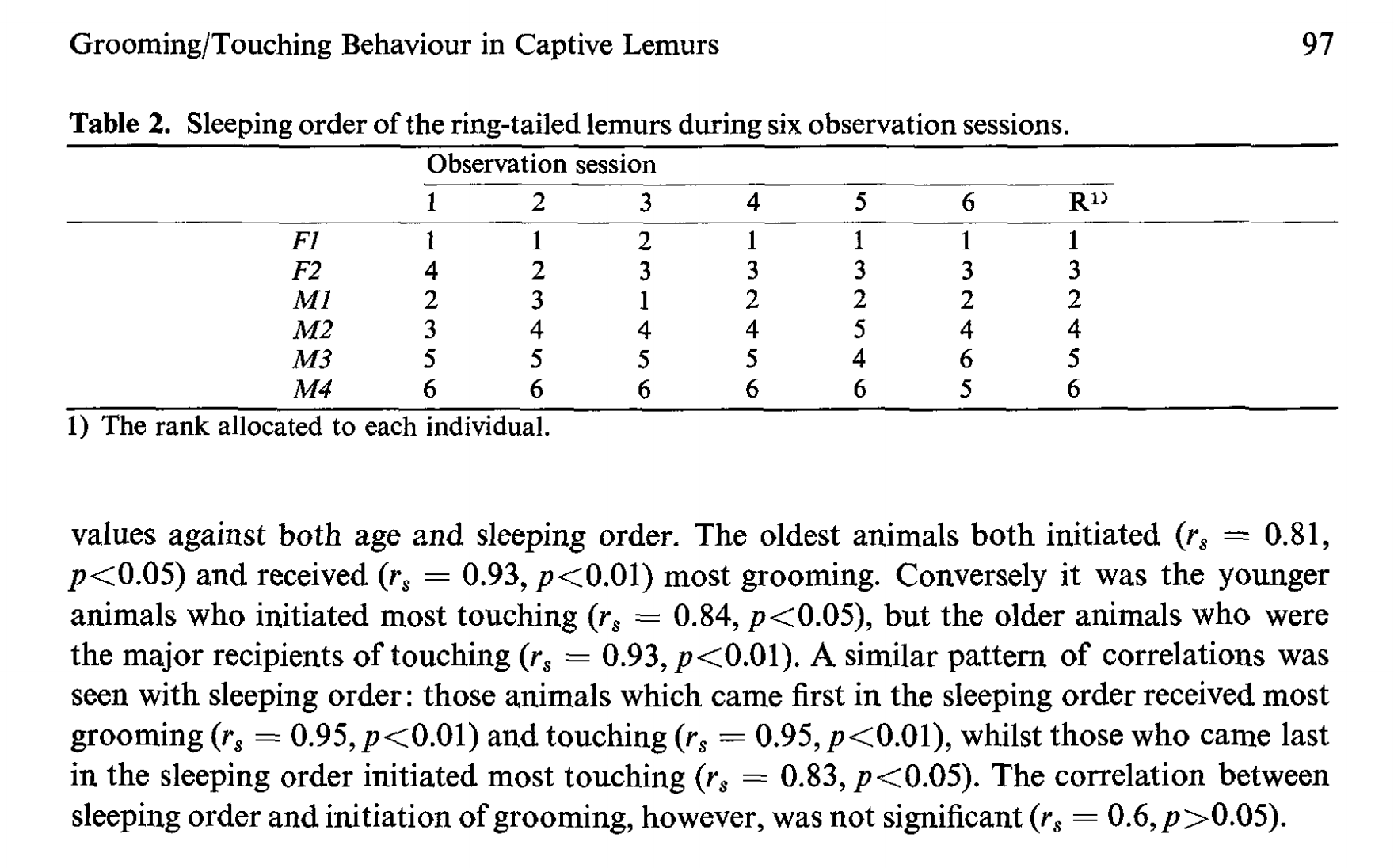
This chart shows that age and gender responds to social hierarchy
within the troop in a captivated environment. F1 is not only the
oldest but also a female RTL. She always gets to sleep first and
gets most touching from other RTLemurs. F2 is younger but because
she is female, she is comparatively the same as the older and the
leading male lemur. Meanwhile M4 who is probably the youngest but
also a male Ring-tailed lemur who initiates most touching and came
last in the sleeping order. This proves that there could really be a
case where a young, male ring-tailed lemur is socially ranked-low to
a point that he is not receiving much touching from other RTlemurs.
“Our results indicate that in this group grooming occurs primarily
between the older and (according to sleep order) higher ranking
animals. This is consistent with what has been observed in other
primate species (see, for example, SEYFART8, 1980). Touching,
however, is primarily done by younger animals to older animals, and
by subordinates to dominants.” In the research, they also concluded
that “"reach out and touch" contact is a submissive gesture in the
ring-tailed lemur.”
That made me wonder if male lemurs would just groom each there
so even the lower-ranking lemurs can enjoy grooming as a social
behavior? Typically the answer is no because "Affiliation, tolerance
and cooperation should occur less frequently among males than among
females, since male repro ductive success is tied to inter-male
competition over access to receptive female”. However, “social
friendly activities such as allogrooming, huddling, and sitting and
resting in”seem to be something observed among males too. But since
male RTL and male RTL are less likely to offer “touch” and
receive”grooming” to each other because of their mutually exclusive
social goals, it gave me a better idea that male RT lemurs M3 and
M4(especially) are my targets who’d be in a suitable social position
for an allogrooming device: They are socially low-ranked; They do
not receive any grooming offering; They wouldn’t groom each other.
Physical making & iterations:
Past iteration - prototype 1:


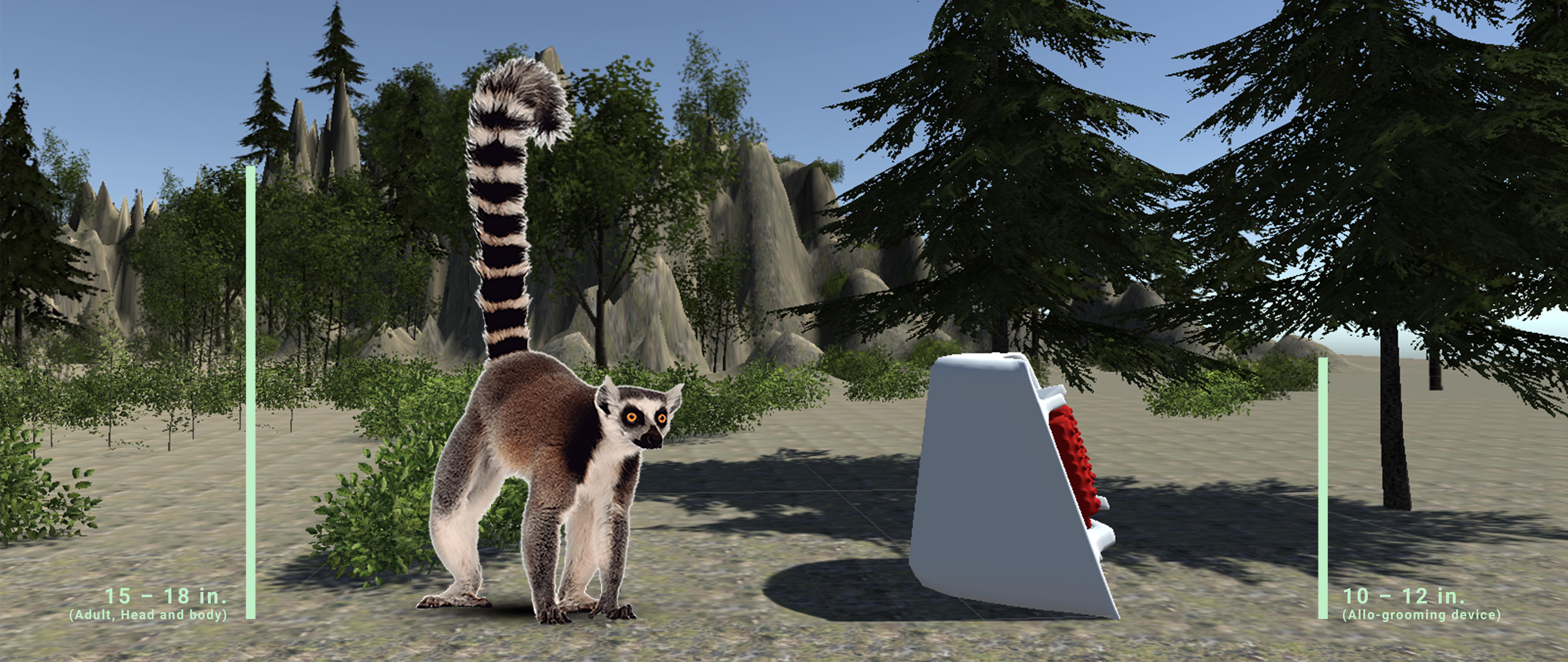
Past iteration - prototype 2:
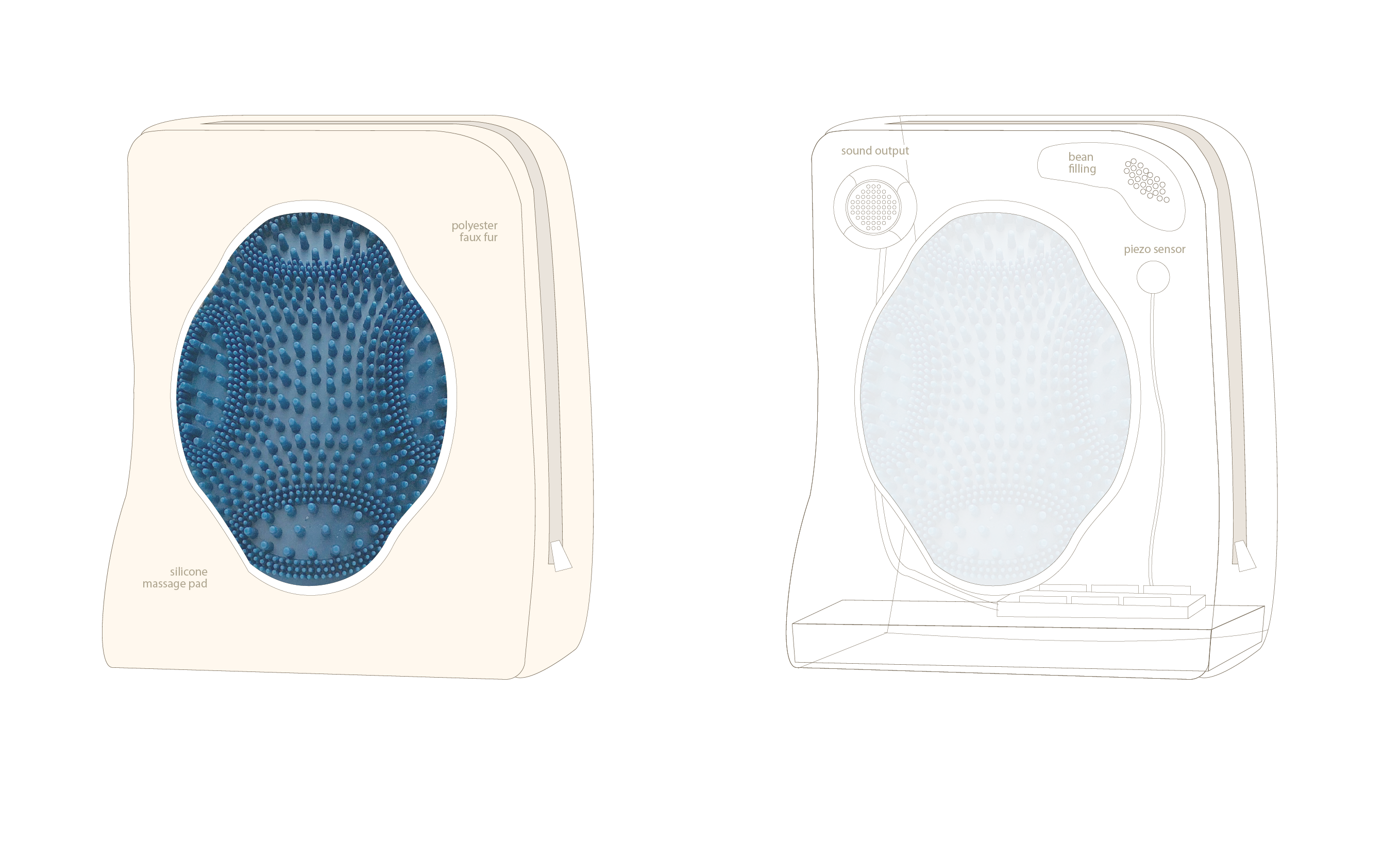
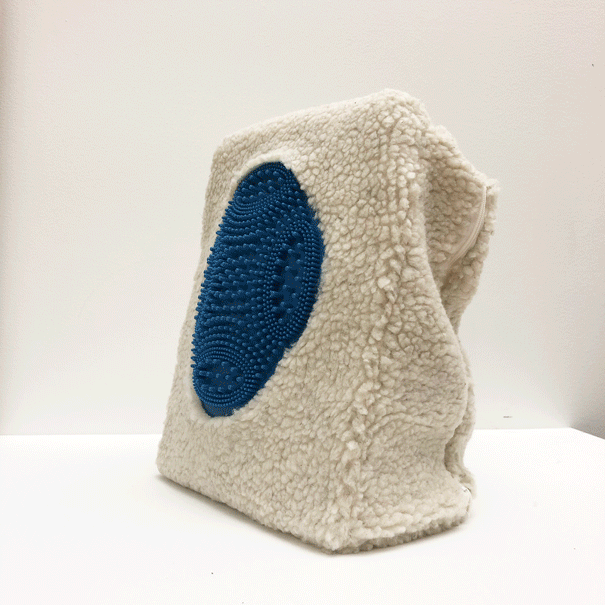
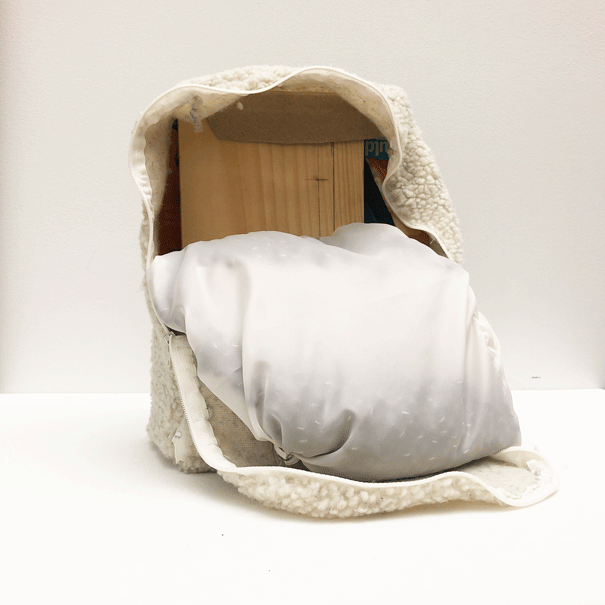
Prototype 3:
Some important feedback I got from the last round of iteration is:1. It’s good to take off the rollers as it’s simpler without losing a purpose.
2. The device looks too much like a backpack, the shape needs to be totally making sense for exclusively RTL
3. The beans will make noise
4. Too much fur, integrate parts into one main material: use silicone
Meanwhile, it is important to re-exmaine the physiology of the device. I went back to exploring and studying postures and physiology of Ring-tailed lemurs when they are sitting, grooming and hugging each other.

sketch:
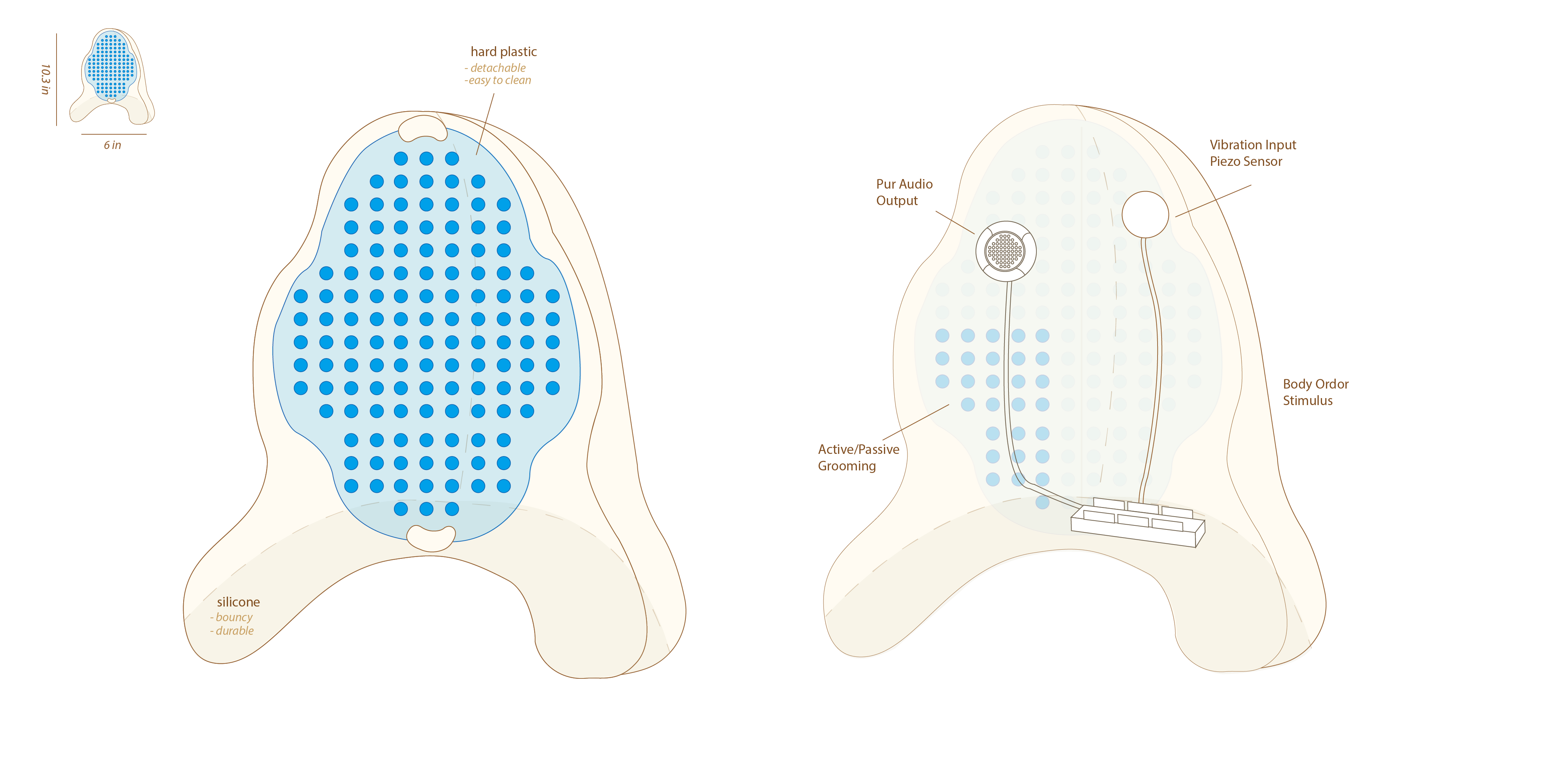
Making:
I decided to make the entire body silicone, including the massage pad. In my head, I thought I could make everything smoothly beautiful by hand, and I will just cut out the part where I will be storing my electronics in the back. Since the body is semi-bouncy, it could potentially work without even a furry outer coat? I also found a home-made silicone sculpture recipe that I really want to try. Apparently, mixing no1 100% silicone with corn starch would give me 10-15 minutes of molding time before it turns into a bouncy, durably hard object. The corn starch is supposed to make it less sticky and easier to work with(like bread or pasta dough).

I started with making the mold of the massage pad from alginate. It didn’t take long for the alginate to set, which was very easy. However, since alginate is water-based, and it was impossible to get the non-liquid, insanely sticky silicone(even without the corn starch)to go into the wet mold with tiny, deep holes in it. I ended up failing making a silicone massage pad, but it’s okay, the pad can stayed as is–hard plastic.

Then I started to handling the silicone. I cut out shape of my device surface/supports from foam to use as my references when molding. Since the home-made recipe makes the silicone doughy, so it’s actually better to form with hands. I did a pretty good job molding my base–smooth and perfectly shape. As I’m running out of corn starch(after two bottles of it), it became insanely difficult to shape the silicone top on top of my original base.

I ended up with a very coarse-looking device that has a pretty lumpy surface. I added two little hooks to hook the massage pad in, so it can be easily detached and washed. The entire body can be washed too, as it’s water-proof. Although, the look and the texture are not perfect(not a ready-to-sell product in the market), the shape and physiology should work well with an actual RT lemur as it’s big enough for them to sit in front while being held from the side legs and it’s roundly pointy enough from the back, which allows one to hug and hold from behind. I’m considering add the zipper fur back as a way to cover up the coarse back surface as well as creating room for storing my electronics.